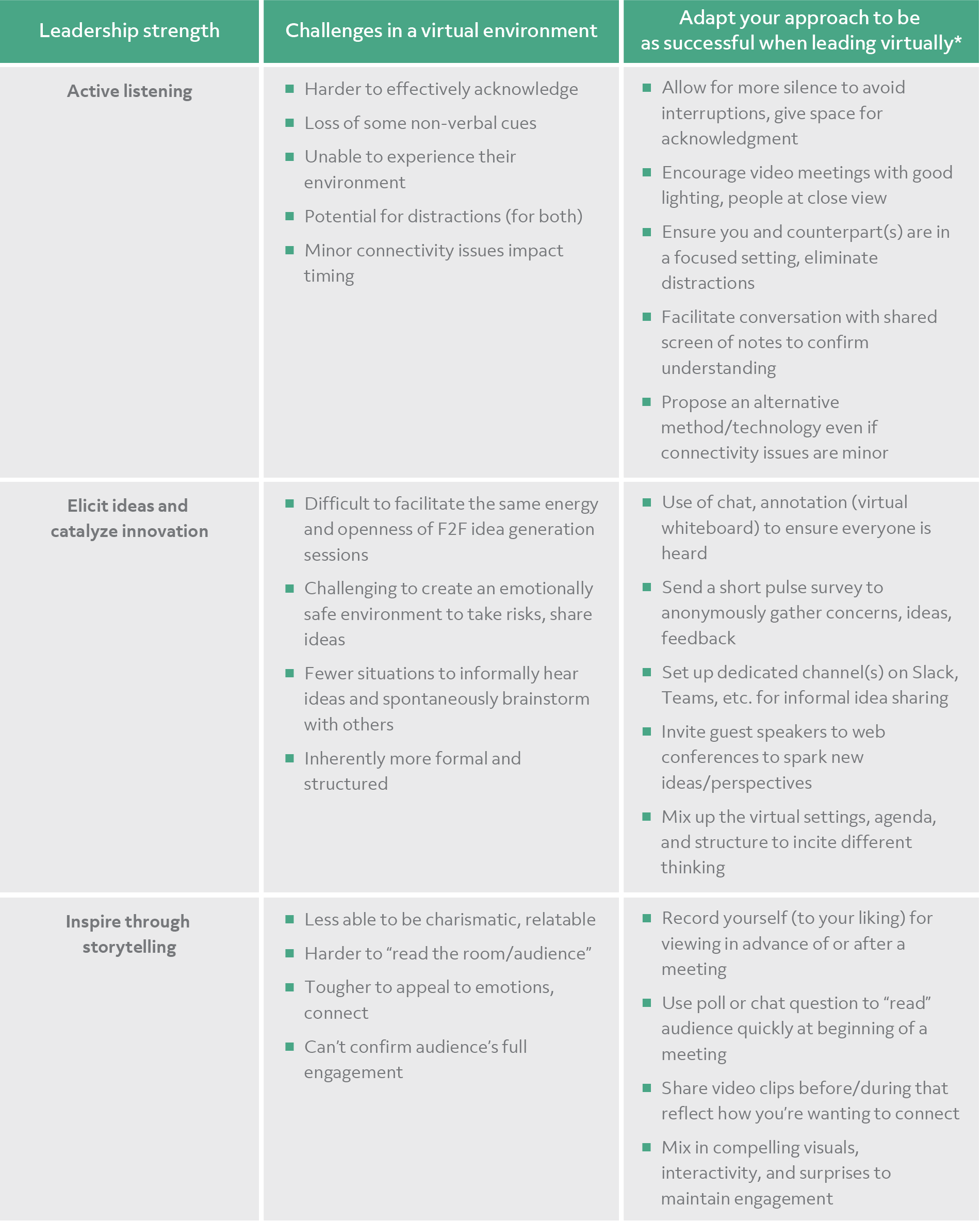
Just like their newly remote teams, leaders wrestle with their own difficulties adjusting to work in a virtual environment. How can leaders adapt quickly, building upon their existing leadership strengths to approach and overcome new, unexpected challenges? Here’s a flexible framework that can help.
Growth and Adaptation in Times of Crisis
“Bad companies are destroyed by crisis; good companies survive them; great companies are improved by them.”
—Andy Grove, 1994
In a call with analysts this spring, Intel CEO Bob Swan echoed his late predecessor’s famous aphorism and noted its resonance in the current context.
Leaders today find themselves sitting—perhaps for the first time—in the same virtual chairs as their geographically dispersed and remotely working employees. As they adapt to circumstances in the wake of the COVID-19 pandemic, their empathy for the differences, limitations, and, in some cases, distinct advantages of working virtually has increased dramatically.
Heightened empathy and understanding help during these tempestuous times, but leaders also wrestle with their own difficulties adjusting to work in a virtual environment. How do they quickly adapt, evolve, and even improve their leadership capabilities, while still honoring and leveraging, as much as possible, the core strengths that shaped their success previously? A simple framework can help leaders think through thorny transitions.
A Flexible Tool for Course Correction
A successful senior leader at a large professional services company, “Sarah” previously traveled regularly in her role, and otherwise worked out of her office at the company’s regional headquarters. Working from home was the exception rather than the rule; Sarah spent the majority of her time making client site visits, leading team meetings in the office, and meeting one-on-one with key stakeholders.
As business circumstances changed almost overnight, Sarah found herself spending weeks just trying to recalibrate her work and responsibilities to adapt to her new reality of working full-time from her home office. Unsure where even to start a course correction, Sarah struggled to understand the changing needs of her colleagues and clients, fumbled for innovative solutions to new problems, and lost steam to mobilize and energize her team when they needed this more than ever—all areas where she typically excelled as a leader.
Whether navigating a global crisis or trying to adapt to more “steady-state” shifts in the business climate and transitions in work, it’s constructive to step back and run through a practical thought exercise to adapt one’s approach.
Sarah used a simple, flexible tool to identify some of her core strengths as a leader and map them to challenges she now faces in a virtual environment. With these challenges listed out, the tool allows Sarah to think through how she can adapt her approach to be as successful as a leader in a virtual environment as she had been in the “previous normal,” as illustrated in the following table.
 *Assumes video conferencing is being used whenever possible
*Assumes video conferencing is being used whenever possible
Leading by Improvement
When using this simple filtering tool, useful insights and behavior changes percolate out of the details as leaders think through the challenges and modifications to their approach. Adaptations that arise for one situation also will apply to other, and leaders can discover new advantages and opportunities when devising fresh approaches to these newly identified obstacles.
“When the Only Constant is Change: Adaptive Leadership for Any Context” compares the mindset of “traditional” vs. “adaptive” leadership, contrasting how traditional leadership mindset seeks certainty, while adaptive leaders listen and embody a mindset of genuine curiosity. During a crisis, successful leaders remain curious—about others’ ideas, and about how they can “do better,” as my colleague Danny Ertel puts it in recent articles on Medium. Leaders should be encouraged to continually seek out opportunities to learn about new practices, creative solutions, and ways they can identify and improve upon gaps (conscious and unconscious) in their leadership style and approach. Leaders extract the most ongoing value out of this type of a filtering exercise when they document and learn from both success and failure as they implement different approaches. As leaders cultivate this growth mindset and humility, they instinctively will apply this tool (or adopt something similar) to the diverse challenges that unexpectedly arise during times of crisis.
Leaders must acknowledge that most individuals did not “sign up” for this full-time virtual working environment. Leading by example is more important than ever during these unprecedented times. Soft skills—such as navigating change and influencing without authority—take on another dimension of complexity in a virtual environment, as we discuss in “Soft Skills, Adaptive Leaders,” our eight-week learning journey for learning and leadership development. Leadership development can help leaders adapt their approaches amidst rapidly changing circumstances—and model how their team members also can improve themselves as individual contributors and as part of the larger evolving organization.
“Great companies are improved by crisis,” as Grove says, but only when their ranks are filled by great leaders who are improved by crisis.
How is your company anticipating and preparing for sudden disruptions? How does leadership development build resiliency by cultivating the key soft skills leaders require to adapt? Take our five-minute soft skills pulse survey and receive our full research report on what your peers have to say.
.png?width=512&height=130&name=vantage-logo(2).png)

